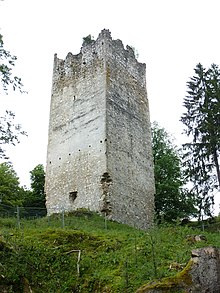Rosegg castle ruins
| Rosegg castle ruins | ||
|---|---|---|
|
Rosegg Castle around 1688 |
||
| Alternative name (s): | Altrosegg | |
| Creation time : | around 1300 | |
| Castle type : | Hilltop castle | |
| Conservation status: | Keep | |
| Place: | Rosegg | |
| Geographical location | 46 ° 35 '5 " N , 14 ° 1' 29" E | |
|
|
||
The ruined castle Rosegg , even Altrosegg called, is one of the 12th or early 13th century, built probably in the second half and expanded until the early 19th century, after the ruin ruined hilltop castle in Carinthia's Rosental . The remains of the castle are now in the Rosegg zoo , which includes the castle hill, and are a listed building .
history
The Rosegger Burgberg was probably the third location of the seat of the Lords of Ras , a noble Carinthian family that was influential in this region. They were servants of the Styrians and sympathizers of the Carinthian dukes and sat first in a castle on the Gratschitzen on the northern slope of the Karawanken, of which only a few remains are preserved today, later in the castle Ras near Sankt Jakob im Rosental , which was first mentioned in a document in 1171 and was abandoned between 1309 and 1317. At this point in time (1171) they already called themselves Lords of Rosegg (or Rasek ), the castle in Rosegg was first mentioned in a document in 1239.
In the 12th and 13th centuries, the speeders procured important fiefdoms and thus established an important rulership and district court district. After the male line of the noble family died out in 1318, the castle came into the possession of foreign noble families, who appointed local administrators. Until its extinction in 1363, the Rosegg rule belonged to the Walsee-Graz family , then it passed to the Pettau family , who also owned the second large Rosental property around the Hollenburg . After this noble family died out in the male line in 1438, the property was passed on to their female descendants. The Hollenburg went to the Stubenbergs in Styria , Rosegg to the Counts of Schaunberg from Upper Austria .
The castle was in good condition in 1468. Repairs were carried out in 1632 and - after a fire - before 1688. In 1605 the brother of Salzburg Archbishop Wolf Dietrich von Raitenau owned the castle, in 1686 the Count Orsini-Rosenberg acquired the property and maintained the castle. Even after the establishment of Rosegg Castle in the valley floor north of the castle hill by Count Franz Xaver Wolfgang von Orsini-Rosenberg from 1772, which was supposed to replace the castle as the manor's seat, the castle was not allowed to deteriorate.
During the French Wars , in 1801, stones from the castle were used to build a wall around the foot of the hill. When in 1806/07 building materials were needed to rebuild the tower of the Rosegg parish church, Prince Orsini-Rosenberg allowed the villagers to use stones from the old castle, and after the village was damaged by the French in 1813, the existing castle was further demolished . Only the keep was largely spared. In 1829 Peter Ritter von Bohr received Rosegg and from 1830 had an animal park laid out. As early as 1833, the rulership of Rosegg passed to Prince Johann von Liechtenstein . The ruins, the castle and the zoo are still owned by his descendants.
Building description
Remains of the Romanesque keep on the north side of the formerly extensive castle complex, which at the end of the 19th century was tried in vain because of its alleged dilapidation, as well as parts of the outer ring wall are preserved.
literature
- Dehio Handbook Carinthia . Verlag Anton Schroll, Vienna 2001, ISBN 3-7031-0712-X , p. 688
- Wilhelm Deuer: Castles and palaces in Carinthia . Verlag Johannes Heyn, Klagenfurt 2008, ISBN 978-3-7084-0307-6 , pp. 26-30.
Web links
- Entry via Rosegg - castle ruins on Burgen-Austria


